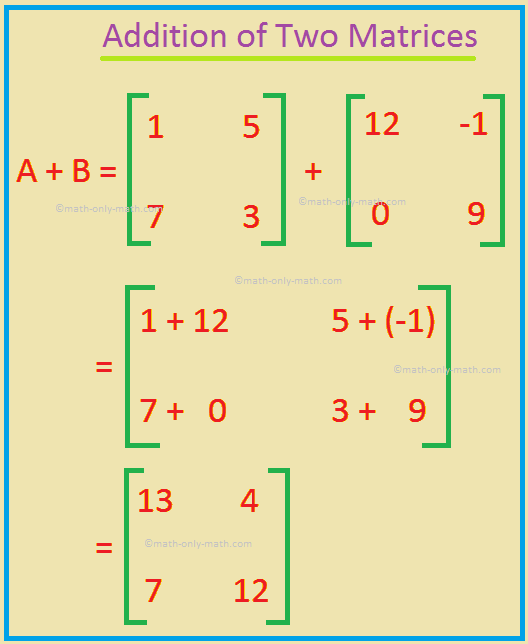Subscribe to our ▶️ YouTube channel 🔴 for the latest videos, updates, and tips.
Addition of Two Matrices
We will learn how to find the addition of two matrices.
Two matrices A and B are conformable (compatible) for addition if A and B are of the same order.
The sum of A and B is a matrix of the same order and the elements of the matrix A + are obtained by adding the corresponding elements of A and B.
Example:
Let A = \(\begin{bmatrix} 12 & 7\\ 3 & -1 \end{bmatrix}\), B = \(\begin{bmatrix} 9 & 3\\ -5 & 4 \end{bmatrix}\), C = \(\begin{bmatrix} 7 & 9 & 5\\ 2 & -3 & 1 \end{bmatrix}\).
(i) A + B can be found because A and B both are of the same order 2 × 2. Adding the corresponding elements,
A + B = \(\begin{bmatrix} 12 + 9 & 7 + 3\\ 3 + (-5) & (-1) + 4 \end{bmatrix}\)
= \(\begin{bmatrix} 21 & 10\\ -2 & 3 \end{bmatrix}\)
(ii) A + C cannot be found because A and C are not of the same order. A is of the order 2 × 2 and C is of the order 2 × 3.
Solved Examples on Addition of Two Matrices
1. If A = \(\begin{bmatrix} 1 & 5\\ 7 & 3 \end{bmatrix}\), B = \(\begin{bmatrix} 12 & -1\\ 0 & 9 \end{bmatrix}\), find A + B.
Solution:
A + B can be found because A and B both are of the same order 2 × 2.
Now adding the corresponding elements we get,
A + B = \(\begin{bmatrix} 1 & 5\\ 7 & 3 \end{bmatrix}\) + \(\begin{bmatrix} 12 & -1\\ 0 & 9 \end{bmatrix}\)
= \(\begin{bmatrix} 1 + 12 & 5 + (-1)\\ 7 + 0 & 3 + 9 \end{bmatrix}\)
= \(\begin{bmatrix} 13 & 4\\ 7 & 12 \end{bmatrix}\)
2. If X = \(\begin{bmatrix} 1 & 0\\ 0 & 1 \end{bmatrix}\), Y = \(\begin{bmatrix} 0 & 1\\ 1 & 0 \end{bmatrix}\), find sum of two matrices X and Y.
Solution:
X + Y can be found because X and Y both are of the same order 2 × 2.
Now adding the corresponding elements we get,
X + Y = \(\begin{bmatrix} 1 & 0\\ 0 & 1 \end{bmatrix}\) + \(\begin{bmatrix} 0 & 1\\ 1 & 0 \end{bmatrix}\)
= \(\begin{bmatrix} 1 + 0 & 0 + 1\\ 0 + 1 & 1 + 0 \end{bmatrix}\)
= \(\begin{bmatrix} 1 & 1\\ 1 & 1 \end{bmatrix}\)
From Addition of Two Matrices to HOME
Didn't find what you were looking for? Or want to know more information about Math Only Math. Use this Google Search to find what you need.



New! Comments
Have your say about what you just read! Leave me a comment in the box below. Ask a Question or Answer a Question.